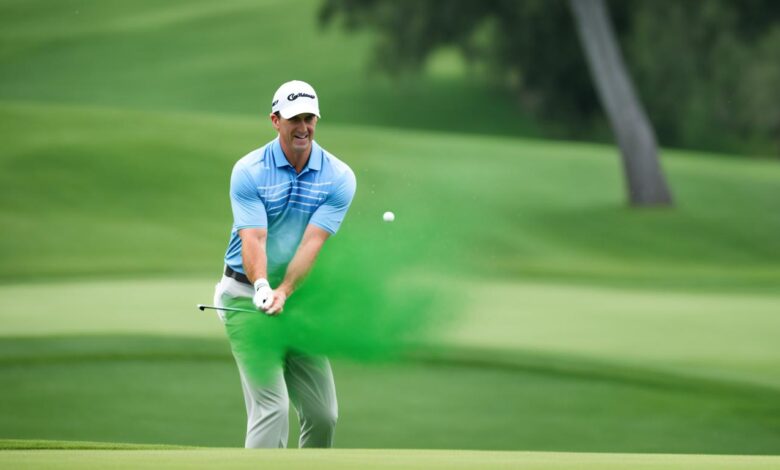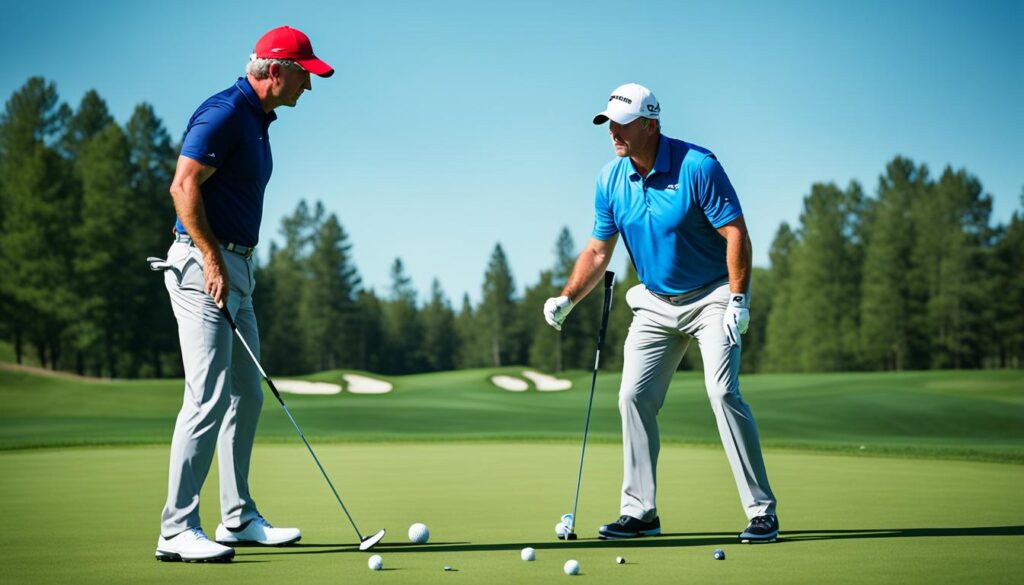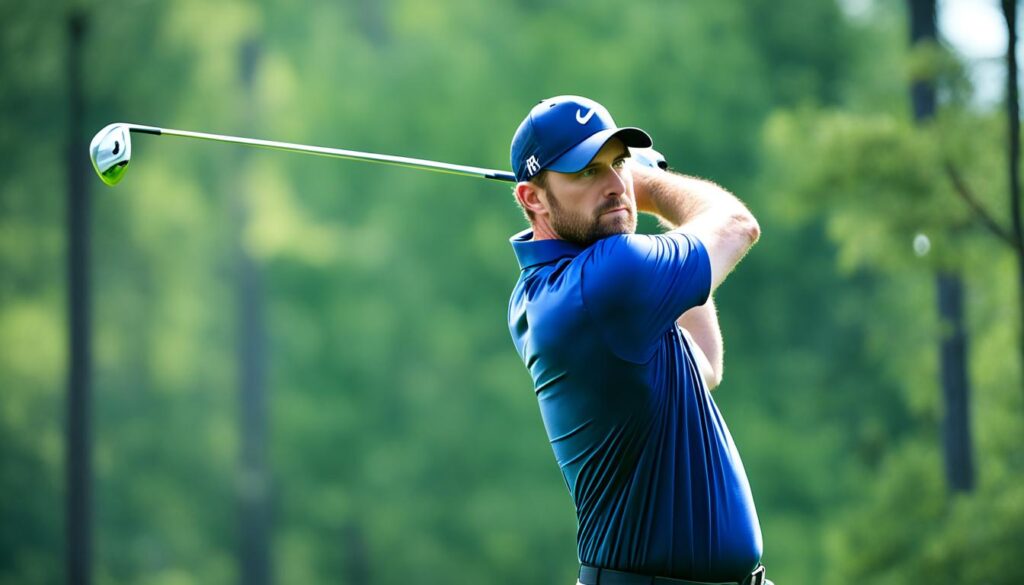How to Fix a Slice: The Ultimate Guide to Straight Shots

According to Golf Digest, pro golfer Tony Finau fixed his slice with coach Boyd Summerhays. They changed his grip, swing, and setup. These changes made his shots go straighter and improve control.1 It’s important for golfers to follow a specific plan. This plan helps correct slices and make their play more accurate. The article mentions many golfers face the slice issue. Yet, it can be solved with technique tweaks and lots of practice.2
Key Takeaways
- The slice is the most common miss among amateur golfers.1
- Struggling with setup and alignment is a key issue for golfers who slice.1
- Analyzing over 1,000,000 swings has shown that poor wrist position is a significant cause of slicing.1
- Approximately 90% of golf players struggle with a slice, indicating a common issue among golfers.2
- Using training aids like the HackMotion device can help improve wrist angles and position during the swing.1
Understanding the Golf Slice
A golf slice is a shot that moves from left to right in the air. It happens for right-handed players. Slices take away from the golfer’s distance and accuracy, bringing frustration.3
Defining the Golf Slice
A slice is when the ball moves away from the golfer’s dominant hand. For right-handed players, this means it moves from right to left.3
The Science Behind a Slice
The angle of the clubface and the swing path affect the ball’s flight. An open clubface and an out-to-in swing cause side spin. This makes the ball curve to the right for right-handed players.3
The Typical Ball Flight of a Slice
A slice shot starts fairly straight but then turns to the right. This leads to less distance and accuracy, often causing problems on the course.3
Common Causes of a Golf Slice
Mastering straight shots starts with fixing a golf slice. Learn what makes your ball fly off course. Then, tweak your grip, stance, and swing to hit truer shots.4
Grip Issues
Hold the club wrong and you might slice. For righties, too much left-hand twist is bad news. It opens the clubface, causing slices.4 Work on a neutral grip. This keeps the clubface from opening and can lessen your slices.
Stance and Posture
Stand and aim right, or you’re likely to slice. A slanted stance can make your swing go wrong. This often leads to slices.4 Line up your feet, hips, and shoulders with the target. This simple fix can help you swing straighter and avoid slices.
Clubface Angle
If your clubface isn’t square, you might slice. A face pointing right at impact can throw off your shot. Learning to hit with a square clubface can help.
Swing Path
Swinging wrong makes slices happen. If your club swoops in from the side, prepare for a slice. Try swinging from the inside. It can straighten your shot.
Diagnostic Tools for Assessing Your Slice
The first step to fixing your golf slice is figuring out why it’s happening. Luckily, many tools and tech are here to help. They show what’s going wrong in your swing and suggest ways to make it better.5
Golf Swing Trainers
Swing trainers like the Swing Plate and Swing Plate Dual Pro are great for getting your swing right. They give instant feedback so you can work on a perfect swing path. This is key to stop a slice.5
Divot Board
Using a divot board can show if your swing path is off. If your divots go left (for righty golfers), it means you’re swinging from out to in. That’s a big reason for slices.5
Golf Impact Bag
Need to fix your slice-causing problems? Try a golf impact bag. It helps you remember the right swing. This gets your clubface and swing path in a better spot.5
how to fix a slice
The key to fixing a golf slice lies in a few main areas. These are your grip, stance, and how you swing the club. It’s about making sure the clubface hits the ball correctly.1 It takes time and practice to get this right, so don’t expect instant results.5
The slice is the most common issue among golf beginners. It’s not easy to overcome and can be really annoying.1 Yet, with the right methods and a lot of effort, you can improve. This will help make your hits straighter and more dependable.5
Combining some technical changes with regular practice is crucial for fixing a slice.5 Work on your grip, stance, swing, and how you control the clubface. This can lead to big changes and cut down on sliced shots.
Drivers are tough because they’re long, making it hard to hit straight.1 Swinging the club in a certain way can also lead to a slice. And, using certain clubs, like a low-lofted driver, can up the slicerisk.5
Using tools like golf swing trainers and divot boards can help a lot.5 They give feedback and build muscle memory. This makes fixing your swing easier.
After checking over 1,000,000 swings, they found something interesting.1 If your wrists move too much, you might slice. A device called HackMotion can reduce this wrist movement. This is a major help against slicing.1
Getting your setup right is key to avoid a slice.1 Having a strong grip can help you hit the ball straight. Plus, putting the ball near your front foot can lead to a straighter shot.1
Grip Adjustments
Adjusting your grip is key to fixing a golf slice. The article suggests making your grip more neutral. For right-handers, aim to have the “V” of your thumb and forefinger point to your right shoulder.6 This helps the clubface stay square and prevents a slice.
A good grip for right-handed players has two V’s pointing to the right shoulder.6 A strong grip means you see three or more knuckles of the left hand. But a slicer’s grip won’t show any knuckles on the left hand.6 If you hold the club in your palms, your swing might be slower with more off-center hits. Fingertip grip allows for more wrist movement, leading to straighter and longer shots.6
The right golf grip can be an easy fix for a golf slice.7 Holding your club in your palms affects wrist movement and swing control.7 You can check your grip with your golf glove. A trick is to see where it’s worn out. Also, turn the logo of your glove during the takeaway to help the clubface’s position.7
Stance and Alignment Corrections
It’s key to line up your feet, hips, and shoulders correctly with your target.3 This is vital for reducing a slice. It shows how crucial the right stance is for golfers aiming to better their shots.3 A square stance makes sure the swing is straight. It’s also crucial to stand balanced with a slight lean forwards from the hips.
3 The piece points out that slicers often place the ball too far forward. This shows a common mistake made by those battling a slice.3 Having a too-wide stance makes moving your weight hard. This can lead to hitting the ball inconsistently, a mistake golfers should work to avoid.
8 Where you place the ball and how your shoulders tilt affect your driver swing.8 It’s important to know how your shoulder position relates to where you’re aiming.8 The angle of your feet can also change your swing’s path and might make you slice.
| Stance Adjustment | Impact on Slice |
|---|---|
| Square Stance | Helps golfer swing on a straighter path3 |
| Forward Ball Position | Common mistake among slicers3 |
| Wider Stance | Can make weight shift difficult and consistent ball striking less likely3 |
| Shoulder Line vs. Target Line | Understanding this relationship is crucial8 |
| Foot Flare | Affects swing path and can contribute to a slice8 |
Backswing and Downswing Modifications
The article advises on a controlled backswing, avoiding too much. This can keep the clubface open9. Finau highlighted keeping the right arm under the left. And ensuring the right arm stays near. This advice improved his shots consistency9. He also stressed making sure the clubface is square at the top of the swing. This influences the whole swing and avoids last-minute changes9.
In the downswing, transition smoothly and focus on inside-to-out swing path9. Finau pointed out the importance of an inside swing. And trusting the clubface position to swing freely without worries9. Adapting his visual aim for swing changes was tough but improved his shots9.
8 Keeping the lead arm straight too long delays clubface release, causing a slice8. Limited body rotation due to flexibility issues can affect the path in the downswing8. Knowing how the shoulder line compares to the target line can prevent a slice. This insight helps maintain power through the swing8.
Clubface Control Techniques
Learning to control the clubface at impact is key to avoid slicing the golf ball.10 This involves using different drills and exercises. They aim to make your swing path go from inside-to-out and keep the clubface square at impact. These steps are vital for lowering the chances of hitting a slice.
Drills and Exercises
One beneficial drill involves swinging with a headcover or stick outside the ball.10 The setup makes you focus on swinging from the inside-out. Otherwise, you’d hit the barrier. This drill builds the muscle memory and eyesight for a square clubface at all points of the swing.
The “towel under the arm” drill is also useful. A towel is placed under the front arm while swinging.11 It ensures you stay connected. This avoids the clubface opening and causing a slice.
Using devices like the HackMotion gadget can be a boost. They enhance wrist and clubface control.11 These tools offer instant feedback. They allow golfers to refine their grip and swing technique. Hence, they make sure the clubface is correct at impact.
Adding these drills and exercises to your practice will enhance your clubface control.1211
Practicing Your New Swing
To improve your swing, practice a lot.9 Set some time aside every day for practice, even if it’s just for a short while. This will make the new swing feel more natural. You can use tools like golf swing trainers, divot boards, and golf impact bags. They give instant feedback and help you get better faster at fixing a slice.12 Try using different golf clubs and hitting at various lengths. This way, you’ll apply the new swing to every part of your game.
Consistency
Practice makes perfect, especially when fixing your swing.9 Spend a little time each day on it. Even short sessions can really help make those changes stick.
Use of Training Aids
Golf training aids like swing trainers and impact bags help a lot.12 They give you feedback right away so you can correct your swing. This speeds up the process of getting rid of a slice.
Varied Distances and Clubs
Using different clubs and hitting at different lengths is crucial. It helps you apply your new swing to the full range of your shots.
Video Analysis
Recording your practices can be very useful. It lets you see your progress and spot areas that need more work.

Troubleshooting Your Slice
Golfers often hit a wall in fixing their slice. They see improvement, then the slice comes back. Relearning old habits is a no-go. Focus on the basics you’ve learned instead.2
Plateaus in Improvement
It’s predictable to stop seeing success after some time. This is when the slice returns for many. It’s critical to stick with what you know is right at this stage.
Doing so means not slipping into old habits. Keep true to what you have learned. This is the way to push through these challenges.
Trust in the fundamentals you’ve practiced. This trust is what leads you out of this bump.2
Overcorrection
Some golfers fix their slice but end up with a hook instead. This is when the ball curves too much the other way. Avoid this mistake.
Don’t make too big of a change too fast. The secret is small tweaks. Gradual adjustments help without creating new problems.12
The Importance of Equipment
The article talks about how the right equipment, like the correct driver and golf ball, can change a golfer’s skill.5 Having the wrong driver or the wrong golf ball can make a golfer slice more. This shows that choosing the right gear is important.
Using clubs that are made to fight slice can really help. This proves that selecting the right club can reduce slicing issues.10
Meeting with a golf club fitter can really improve things. They can adjust your equipment based on how you swing.10 This way, your gear fits you perfectly, reducing the chances of slicing.5
Drills and Exercises for Slice Correction
To fix a golf slice, use drills focusing on grip, swing path, and clubface. These practices help build muscle memory and correct mechanics. This results in straighter, more reliable shots.
Wrist Extension Feedback
The HackMotion device offers real-time wrist feedback. It’s key for reducing a golf slice. Golfers learn the right wrist position during their swing.13
Club Path Drill
An alignment stick at a 45-degree angle is great for over-the-top swings. It promotes an inside-to-out path. This change is crucial for lessening a slice.13
Clubface Drill
Using a glove and tee makes maintaining a square clubface easier. It lessens side spin, thus reducing slices.8
Towel Under Arm Drill
A towel under the lead arm encourages maintaining connection. It prevents an open clubface and reduces slices. It teaches arm and body unity for a smoother swing.8
Headcover Drill
The headcover drill avoids over-the-top motions that cause slices. It helps with an important inside-to-out swing path. Golfers learn to swing correctly using this method.13
Practice these drills often to improve swing mechanics and muscle memory. Over time, these correct the golf slice. Your shots will become more precise and dependable.

Conclusion
Fixing a golf slice takes time, focus, and a step-by-step method. It’s important to understand what causes a slice, like a wrong grip or a faulty swing. But you can correct these by making changes to how you swing and practicing often.14
It’s key to use specific drills and checks to learn more about your swing. This way, you can get rid of your slice and play better. Also, it’s good to practice with all your clubs, not just one type.1415 This helps fix your swing and makes you feel more sure about hitting the ball right.14
Getting your golf swing just right is a journey that never really ends. But with the right steps and lots of practice, you can make big improvements. The advice and tips in this article are useful for golfers at any level. They can help you get over your slice and improve your whole game.14 So remember, there’s always room to get better at golf.
FAQ
What is a golf slice?
What are the primary factors that influence ball flight and cause a slice?
What are the common causes of a golf slice?
How can diagnostic tools help in assessing and fixing a golf slice?
What are the key adjustments and techniques for fixing a golf slice?
How important is consistent practice in eliminating a golf slice?
What are some common challenges and pitfalls when trying to fix a golf slice?
How can equipment impact a golfer’s tendency to slice?
What are some effective drills and exercises for correcting a golf slice?
Source Links
- https://hackmotion.com/how-to-stop-slicing-driver/
- https://www.golfdigest.com/story/fix-your-slice-hank-haney
- https://swingtrainer.com/blogs/instruction/how-to-fix-slice-golf
- https://golf.com/instruction/10-reasons-why-you-keep-slicing-the-golf-ball
- https://www.golftrainingaids.com/blogs/articles/how-to-fix-a-golf-slice
- https://danfordgolfinstruction.com/how-to-grip-a-golf-club-to-fix-a-slice/
- https://usgolftv.com/instruction/the-correct-golf-grip-to-finally-cure-the-slice/
- https://golf.com/instruction/most-read-slice-fix-2022/
- https://www.golfdigest.com/story/slice-proof-swing
- https://yattagolf.com/blogs/golf-tips-and-training/how-to-fix-your-slice-a-step-by-step-guide
- https://hackmotion.com/how-to-fix-slice-in-golf/
- https://practical-golf.com/golf-slice
- https://usgolftv.com/instruction/fix-your-golf-slice-with-these-drills/
- https://www.swingtuneup.com/post/fixing-slices
- https://pitchgolf.london/news/mastering-your-swing-how-to-fix-your-slice/

